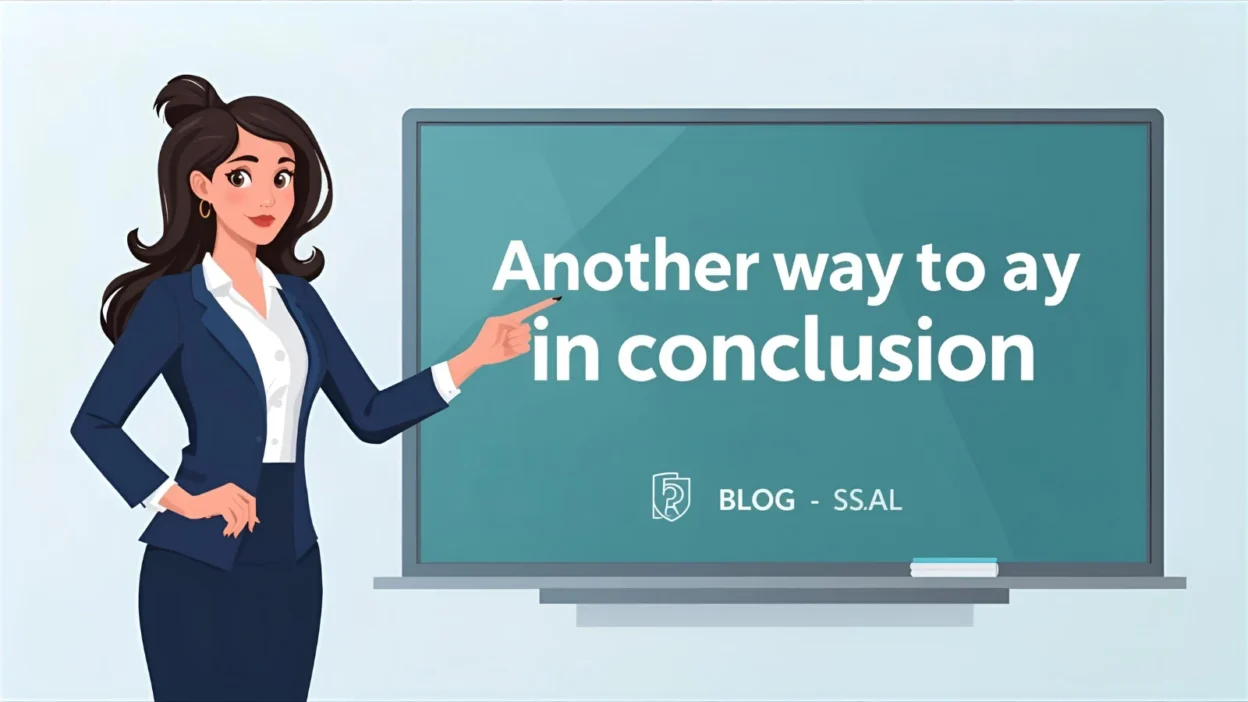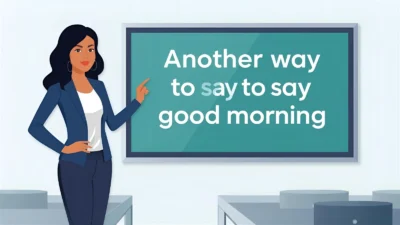The phrase “in conclusion” is one of the most commonly used ways to end an essay, presentation, or speech. While it works well to signal closure, using it too often—or in the wrong context—can feel repetitive or overly formulaic. By learning alternatives, you can vary your style, match your tone, and make your communication more memorable.
This guide introduces 25 powerful alternatives to “in conclusion”—each with meaning, explanation, usage example, best context, and tone. Whether you’re writing an academic paper, giving a business presentation, or crafting a speech, these variations will help you wrap up more effectively.
1. To Sum Up
Meaning: Provides a brief summary of the main points.
Detailed Explanation: Concise and widely used, it’s clear without being too formal.
Scenario Example: To sum up, teamwork and planning were the keys to success.
Best Use: Essays, presentations, everyday writing.
Tone: Neutral, straightforward.
2. In Summary
Meaning: Signals a recap of the main ideas.
Detailed Explanation: Slightly more formal than “to sum up” and common in academic writing.
Scenario Example: In summary, renewable energy offers both economic and environmental benefits.
Best Use: Reports, academic work, professional documents.
Tone: Formal, professional.
3. To Conclude
Meaning: Indicates the final statement or point.
Detailed Explanation: Direct and professional, often used in speeches or formal writing.
Scenario Example: To conclude, we must take urgent action to reduce emissions.
Best Use: Speeches, essays, business writing.
Tone: Formal, authoritative.
4. In Closing
Meaning: A polite way to wrap up thoughts or remarks.
Detailed Explanation: Often used in speeches, presentations, or letters.
Scenario Example: In closing, I’d like to thank everyone for their hard work.
Best Use: Public speaking, professional emails.
Tone: Respectful, polite.
5. Overall
Meaning: Gives a broad summary of the discussion.
Detailed Explanation: Casual and concise, good for both speech and writing.
Scenario Example: Overall, the campaign was a huge success.
Best Use: General writing, presentations, reports.
Tone: Neutral, reflective.
6. All in All
Meaning: Wraps up a discussion with a general conclusion.
Detailed Explanation: Informal, conversational alternative.
Scenario Example: All in all, it was a great experience for the whole team.
Best Use: Casual writing, speeches, conversations.
Tone: Friendly, relaxed.
7. As a Result
Meaning: Indicates the outcome of the discussion.
Detailed Explanation: Highlights consequences rather than just summarizing.
Scenario Example: As a result, we decided to invest in renewable energy.
Best Use: Analytical writing, reports, essays.
Tone: Logical, formal.
8. In Brief
Meaning: Signals a very short summary.
Detailed Explanation: Works best when you’re simplifying complex content.
Scenario Example: In brief, our research shows strong potential for growth.
Best Use: Reports, academic writing, summaries.
Tone: Concise, professional.
9. To Wrap Up
Meaning: Informal way to conclude.
Detailed Explanation: Common in presentations and casual speech.
Scenario Example: To wrap up, let’s review our goals for next quarter.
Best Use: Presentations, conversations.
Tone: Casual, engaging.
10. In Essence
Meaning: Expresses the core meaning of what has been said.
Detailed Explanation: Slightly philosophical and reflective.
Scenario Example: In essence, innovation is about solving real problems.
Best Use: Speeches, reflective writing.
Tone: Thoughtful, formal.
11. Thus
Meaning: Indicates logical conclusion from earlier points.
Detailed Explanation: Concise, often used in formal and academic contexts.
Scenario Example: Thus, we can conclude that climate change is a global priority.
Best Use: Academic writing, research, analysis.
Tone: Formal, logical.
12. Finally
Meaning: Signals the last point or closing remark.
Detailed Explanation: Very common in both writing and speaking.
Scenario Example: Finally, let’s thank our partners for their continued support.
Best Use: Presentations, essays, speeches.
Tone: Neutral, clear.
13. At the End of the Day
Meaning: Emphasizes the ultimate takeaway.
Detailed Explanation: Informal and conversational, best for speech.
Scenario Example: At the end of the day, success depends on teamwork.
Best Use: Speeches, conversations, blogs.
Tone: Casual, reflective.
14. In Short
Meaning: Offers a condensed version of the main idea.
Detailed Explanation: Efficient and versatile.
Scenario Example: In short, digital transformation is no longer optional.
Best Use: Essays, presentations, casual writing.
Tone: Concise, straightforward.
15. Ultimately
Meaning: Stresses the final or most important point.
Detailed Explanation: Works well when emphasizing long-term outcomes.
Scenario Example: Ultimately, education is the foundation of progress.
Best Use: Analytical writing, speeches.
Tone: Formal, persuasive.
16. To Recap
Meaning: Reviews the key points covered.
Detailed Explanation: Conversational and engaging, often used in presentations.
Scenario Example: To recap, we covered strategy, execution, and results.
Best Use: Presentations, discussions.
Tone: Casual, clear.
17. In a Nutshell
Meaning: Summarizes in a compact way.
Detailed Explanation: Informal and playful, suitable for speech and casual writing.
Scenario Example: In a nutshell, hard work pays off.
Best Use: Blogs, casual conversations, light writing.
Tone: Informal, witty.
18. As We Have Seen
Meaning: Refers back to evidence or discussion points.
Detailed Explanation: Helps reinforce conclusions with prior analysis.
Scenario Example: As we have seen, small businesses drive economic growth.
Best Use: Academic essays, research writing.
Tone: Formal, analytical.
19. As Demonstrated
Meaning: Wraps up by pointing to proven evidence.
Detailed Explanation: Works best with case studies or data-driven arguments.
Scenario Example: As demonstrated, teamwork increases productivity.
Best Use: Reports, research, persuasive writing.
Tone: Confident, factual.
20. As Stated
Meaning: Draws closure by returning to a main point.
Detailed Explanation: Reminds the reader of earlier content to close the discussion.
Scenario Example: As stated, innovation is essential for growth.
Best Use: Business writing, reports.
Tone: Formal, professional.
21. For These Reasons
Meaning: Connects the conclusion to supporting evidence.
Detailed Explanation: Reinforces a logical outcome.
Scenario Example: For these reasons, we must act now to protect the environment.
Best Use: Arguments, essays, persuasive writing.
Tone: Persuasive, logical.
22. As a Final Point
Meaning: Indicates the last and important remark.
Detailed Explanation: Signals closure while giving emphasis.
Scenario Example: As a final point, remember that persistence leads to results.
Best Use: Speeches, presentations.
Tone: Formal, emphatic.
23. Hence
Meaning: Concludes with logical deduction.
Detailed Explanation: Similar to “thus,” but slightly more formal.
Scenario Example: Hence, adopting renewable energy is the way forward.
Best Use: Academic writing, formal analysis.
Tone: Formal, precise.
24. To Bring It All Together
Meaning: Connects all parts into one closing idea.
Detailed Explanation: Strongly unifying and effective in speeches.
Scenario Example: To bring it all together, collaboration is our greatest strength.
Best Use: Public speaking, team meetings.
Tone: Warm, inclusive.
25. The Bottom Line Is
Meaning: States the final takeaway in plain terms.
Detailed Explanation: Informal and impactful, often used in business contexts.
Scenario Example: The bottom line is, customer trust determines success.
Best Use: Business presentations, casual writing.
Tone: Direct, impactful.
Conclusion
Although “in conclusion” is a standard phrase, using it exclusively can feel repetitive. By choosing from these 25 alternatives, you can close your writing or speech in ways that are more persuasive, polished, or conversational depending on your audience. A strong ending leaves a lasting impression—so vary your phrasing to keep your communication powerful and memorable.



